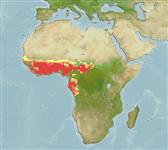ماهبان شعاع باله >
Siluriformes (Catfish) >
Claroteidae (Claroteid catfishes) > Claroteinae
Etymology: Chrysichthys: Greek, chrysos = golden + Greek, ichthys = fish (Ref. 45335).
Issue
The species Chrysichthys furcatus Günther, 1864 is considered valid in Eschmeyer (CofF ver. Mar. 2012: Ref. 89686). It is treated here a synonym of Chrysichthys nigrodigitatus (Lacepède, 1803) following Risch (1992: Ref. 7324), Risch (2003: Ref. 57126) and Geerinckx et al. (2007: Ref. 81642).
محيط زيست / آب و هوا _ اقليم / Range
بوم شناسي
; آب شيرين نزديك كف زي; رود رو (Ref. 51243); تغييرات عمق 3 - ? m (Ref. 13851). Tropical; 22°C - 28°C (Ref. 12468), preferred ?; 15°N - 13°S, 16°W - 30°E
Africa: Senegal to Cabinda, Angola (Ref. 3236). Reported from Mauritania (Ref. 55783). Also present in the lower Congo River (Ref. 1879).
Length at first maturity / Size / Weight / سن
Maturity: Lm ?, range 14 - ? cm
Max length : 65.0 cm SL جنس نر / بدون خواص جنسي; (Ref. 3236)
خارهاي باله پشتي (کل): 2; شعاع نرم باله پشتي (کل): 6; خارهاي باله مخرجي 0. Diagnosis: recognized by its pointed snout, the rather small mouth, and the width of the premaxillary tooth plate (1/5-1/3.5, usually 1/4, of head length); vomerine dentition represented by a square to rectangular tooth plate which begins to develop at sizes between 60 and 70 mm standard length; palatine dentition developing at sizes over 100 mm standard length, initially as isolated teeth; second or third branched dorsal-fin ray always the longest; upper caudal-fin lobe much longer than lower lobe; gill rakers long and smooth; other characters, such as length of dorsal fin, number of branched rays in anal fin, and number of gill rakers on first gill arch, are subject to intraspecific variations; sexually mature males and ripe females show considerable morphological differences; such specimens have often been labelled as Chrysichthys furcatus; maturity occurs probably at a rather advanced stage (at over 200 mm SL) and leads to the inflation of head, broadening of mouth and premaxillary tooth plate, shortening of spines and overgrowth of fin-spines by thick skin, the fins becoming more rounded, and the caudal-fin lobes sometimes becoming subequal; the body acquires an emaciated appearance (Ref. 57126).
Adults occur in shallow waters of lakes (less than 4 m), over mud and fine sand bottom. Omnivorous, feed on seeds, insects, bivalves and detritus (Ref. 13851). Feeding becomes specialized with age and size, larger fish may feed on decapods and fish (Ref. 27935).
Risch, L. and E.J. Vreven, 2007. Claroteinae. p. 607-629. In M.L.J. Stiassny, G.G. Teugels and C.D. Hopkins (eds.) The fresh and brackish water fishes of Lower Guinea, West-Central Africa. Volume I. Collection Faune et Flore tropicales 42. Institut de Recherche pour le Développement, Paris, France, Muséum National d’Histoire Naturelle, Paris, France, and Musée Royal de l’Afrique Centrale, Tervuren, Belgium. 800 pp. (Ref. 74659)
وضعيت در فهرست قرمز IUCN (Ref. 115185)
CITES (Ref. 94142)
Not Evaluated
خطر برای انسان ها
Harmless
استفاده انسانی
ماهي گيري – شيلات: ارزش تحاري اندك; آبزي پروري: تجاري; ماهي ها ي سرگرم كننده: بله; آكواريوم: آکواریوم عمومی
اطلاعات بيشتر
مراجعآبزي پرورينمايه آبزي پرورينژادهاژنتيكتواتر آلل هاوارثبيماري هافرآوریMass conversion
همكارانعکس هاStamps, Coinsصداهاسيگواتراسرعتنوع شناگریمنطقه آبششيOtolithsمغزهابینایی
ابزارها
گزارش های ويژه
بارگيری XML
منابع اينترنتي
